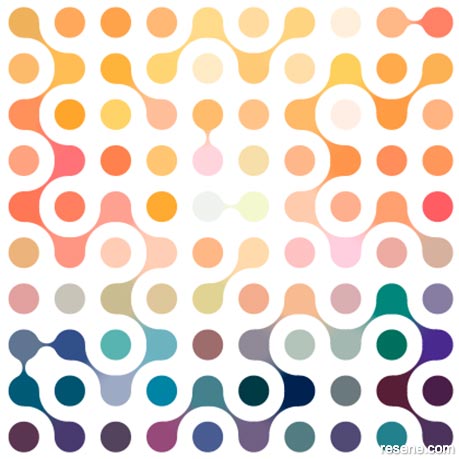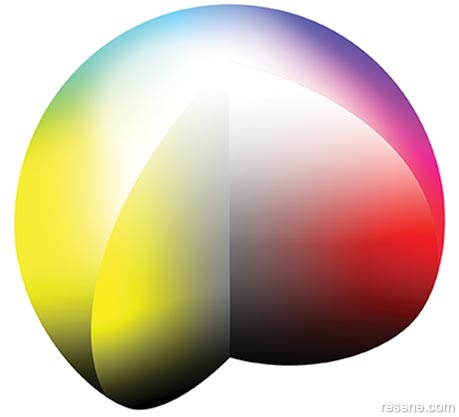From BlackWhite magazine - issue 03
Getting the ΔE down to a T – A crash course on colour accuracy.

Did you know? The human eye has different sensitivities across the spectrum. The sensitivity is to pale acidic green/yellow hues. However, a ΔE of 5 is hardly noticeable in a strong, saturated red.
ΔE is a standard measurement created by the Commission Internationale de l’Eclairage (International Commission on Illumination) that quantifies the difference between two colours. ΔE is measured on a scale from 0 to 100, where 0 indicates no colour difference and 100 is a complete distortion. Standard perception ranges are:
The lower a ΔE figure, the greater the accuracy. A high ΔE level, on the other hand, indicates a significant mismatch. As for the meaning of the term itself, Δ or ‘Delta’ is a Greek symbol that stands for the incremental change of a variable and the ‘E’ stands for empfindung – the German word for sensation. So together, it represents a difference in sensation.
Understanding the meaning and standards of ΔE is useful as it provides you a foundational metric of colour accuracy. It’s a single figure that can be used to quantify whether colours are correct rather than relying on subjective opinions.
While you can use scales and rulers to measure weight and size, light is a bit more ambiguous. Resene uses colorimeters, which are sophisticated tools that measure light through a set of optical XYZ filters designed to mimic the optical characteristics of tristimulus (XYZ) values. Tristimulus values are the foundation of colour language and are also referred to as the CIE colour system, which expresses colours in three dimensions (lightness, redness-greyness and yellowness-blueness).
Once you have a measurement for each colour, the ΔE can be calculated through a mathematical formula.
At the end of the day, if you specify a particular Resene colour it’s because that’s the colour you or your client want something to be. Sometimes, you’re going to want to paint different types of materials in the same Resene colour that are going to require different products to get the right adhesion and durability. The Resene Total Colour System has interlinked systems for decorative and high performance coatings which allow you to achieve the same spectrum of colours in a wide variety of products.

The CIE colour system expresses colours in three dimensions – lightness, redness-greyness and yellowness-blueness – so it's best understood in the form of a sphere where gradations occur on X,Y and Z axes.
The colour lab at Resene is extremely fussy about the ΔE they’re willing to settle for. When it comes to whites, they aim for a difference of 0.4 or less. It takes a lot of smart people doing a great deal of testing, finessing and rejecting of colours to meet that standard. But in the end, it means that – as far as your eyes can see – you are going to have a seamless colour match between one material and the next.
Since colours eventually breakdown from exposure to UV light, heat and other environmental factors, Resene master colour standards are preserved in a freezer to ensure the colour is kept consistent. Each batch of Resene colour charts, drawdown paint swatches and testpots are checked carefully against these standards to ensure colours remain consistent. Resene also keeps a mathematical spectral curve of all its standards that is a permanent record of the colour as it never changes. This is measured using a spectrophotometer, which is regularly externally calibrated.
When it comes to colour standards, the reason Resene is so fussy is that a checked colour may be either side of a colour standard. For example, one white colour may be a little redder and one may be a little yellower. While each of those colours could fall within the 0.4 threshold when compared to the original colour standard, if the two samples are compared, their ΔE will be greater as they lie on different sides of the colour standard. By keeping the white ΔE down to 0.4, if one colour sample happens to sit on the yellower side and another on the redder side, their combined ΔE will still be less than 0.8 – which is not considered perceptible to the normal eye.
Resene colour charts are made with Resene SpaceCote Low Sheen, with Resene FX Metallic, Resene Hi-Glo Miox and Aluminium and Resene Non-Skid Deck & Path used for those finishes. The only chart with swatches made from ink is the Resene wood stains chart because it is not technically possible to successfully finish the wood stain swatches with the same wood stain you would use on your project. Using actual Resene paint improves accuracy when you’re sharing your plans for colour with your client as the paint colour on the swatch behaves the same way as it will on the wall.
Every Resene colour is made with its own unique formulations using tinters which are made by, and exclusive to, Resene. No matter what may be said, a match is never a true match unless it uses the original materials. You can buy a burger at a fast food location or a burger at an upmarket restaurant – both in theory have all the same ingredients: a burger bun, patty, lettuce and dressing – yet the end result is drastically different. The same happens with colours; the nuances of tinters, the undertone of each base and the way each tinter interacts with another means that colours will show different undertones when exposed to different lighting. This is usually exacerbated when seen in combination with other colours, as the lighting changes and as the coating ages.
When you’ve done the hard work of designing a great project, it deserves to be finished with quality and consistency; so make sure you specify both the Resene colour and the Resene product for each surface so that your client gets the authentic colour. There are many customers horrified to find their new colour doesn’t look like what they expected, only to find later that another product was substituted and they didn’t get the Resene finish they expected. This is a false economy as it ends with frustrated and disappointed clients and more labour and product to repaint the surfaces in the authentic Resene colour and paint. When it comes to painting, most of the cost is in the painting. Only a small fraction of the cost is in the paint itself, so it makes sense to specify the colour and paint so you can ensure your client gets the finish and colour they are expecting.
Beyond sophisticated tinting technology, the Resene Total Colour System also offers a wide range of services including colour tools such as charts, drawdowns and electronic tools through to special colour matches and complete colour scheme development by specialised staff to help with the colour decision making process.
› Check out www.resene.com/totalcolour to stay on top of the latest developments – and you may just find a new-to-you tool that can help make your next project easier.
This is a magazine created for the industry, by the industry and with the industry – and a publication like this is only possible because of New Zealand and Australia's remarkably talented and loyal Resene specifiers and users.
If you have a project finished in Resene paints, wood stains or coatings, whether it is strikingly colourful, beautifully tonal, a haven of natural stained and clear finishes, wonderfully unique or anything in between, we'd love to see it and have the opportunity to showcase it. Submit your projects online or email editor@blackwhitemag.com. You're welcome to share as many projects as you would like, whenever it suits. We look forward to seeing what you've been busy creating.
Earn CPD reading this magazine – If you're a specifier, earn ADNZ or NZRAB CPD points by reading BlackWhite magazine. Once you've read an issue request your CPD points via the CPD portal for ADNZ (for NZ architectural designers) or NZRAB (for NZ architects).